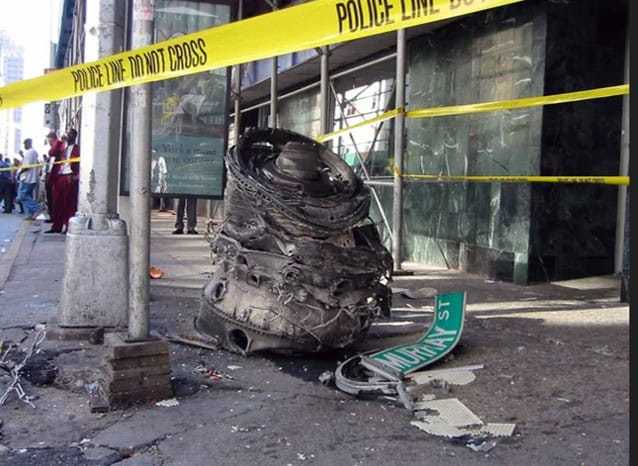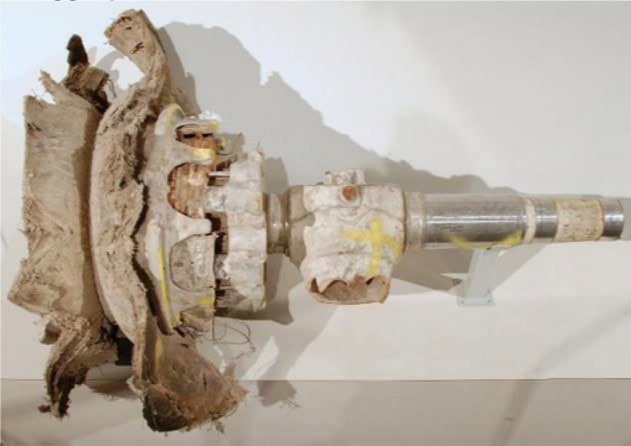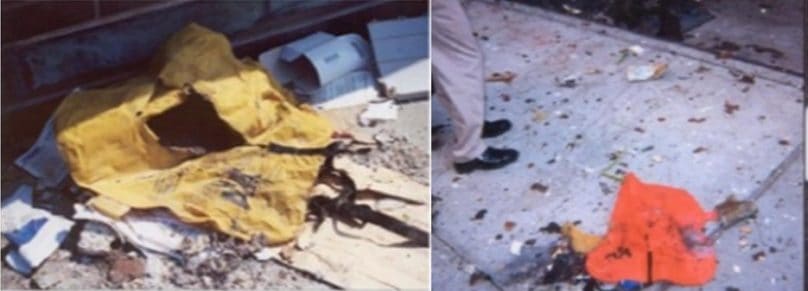(Note 9-15-2025. As of today, I have made revisions to this post. Sometimes I have marked them with the date and in italics. However, since they involve both deletions and insertions, and are fairly frequent, I have occasionally left some unmarked, as it would otherwise interrupt the flow too much.)
Few historical events have ignited more controversy among truth-seekers than the attacks of September 11, 2001 (controversy this post might contribute to). Much bitterness has been exchanged over the manner in which the Twin Towers collapsed, the fate of the planes, and who the event’s chief perpetrators were. I had received some caustic tongue-lashings myself about over-speculative things I said concerning 9/11, and in 2019 was in the midst of writing a book about the attacks. I had resolved to correct past mistakes I’d made, to avoid speculation, and to discuss nothing that an attorney couldn’t present in a legitimate, evidence-based courtroom overseen by a principled judge.
I accumulated more than 800 pages of writing and research notes. I consulted innumerable books and blogs—foreign and domestic—about 9/11, regardless of perspective. I didn’t want to prejudicially rule anything out. I read The New Pearl Harbor by David Ray Griffin, Where Did the Towers Go? by Dr. Judy Wood, Another Nineteen by Kevin Ryan, Welcome to Terrorland by Daniel Hopsicker, 9/11 Synthetic Terror by Webster Tarpley, The Star and the Sword by Wayne Madsen, and countless other volumes. I tracked down rare foreign books, such as Half Truth by Pakistani author Ferrukh Mir, Guarding Bin Laden by Nasser Al-Bahri, and The FBI Accomplice of 9/11 by France’s Patrick Pasin. I visited all the major 9/11 Truth websites: The Corbett Report, Christopher Bollyn, Architects and Engineers for 9/11 Truth, Pilots for 9/11 Truth, Let’s Roll Forums, and many others. I joined a 9/11 Truth group lined with experts—a former Boeing pilot, a former air traffic controller, a former Boeing engineer, a physicist, and several others with relevant expertise, including a researcher who had acquired more data about 9/11 through FOIA requests that anyone else I know, with whom I had countless exchanges. Not wanting to trash the official side without knowing it thoroughly, I was about halfway through the 9/11 Commission’s report when COVID struck. Realizing that the Deep State had unleashed its latest step in imposing totalitarian control, I dropped the 9/11 project and worked flat-out to write my book COVID-19 and the Agendas to Come, Red-Pilled. As more Deep State initiatives continued unfolding, I never returned to the 9/11 book.
However, there are certain aspects of 9/11 that still hold my attention. For example, I don’t think I’ll ever be convinced that the importance of the software firm Ptech—whose role in 9/11 was largely uncovered by JPMorganChase senior consultant Indira Singh, and whose investigation by the media was squelched by the Bush administration—should be underestimated. It was one of many 9/11 dimensions I never had a chance to finish exploring.
However, there was an online mistake I made concerning 9/11 that I feel I owe it to my readers to correct.
In 2017, I wrote a post called “9/11 Simplified.” It introduced a unique theory and has been fairly popular over the years. However, that theory was based on a premise that has turned out false. I subsequently put a disclaimer at the start of the post, but I didn’t delete the article because it still had good information in it. However, as the post continues to get hits, I’ve decided to write a full correction.
I wrote the article with the help of two flight professionals: an Airbus captain who trains pilots, and whose knowledge of flight mechanics is outstanding (I called him “Pilot A”, as he is still an active commercial pilot); and a retired career flight attendant, Mary Ellen Moore.
All three of us were operating on the doctrine—held by many in alternative media—that no actual planes had struck the 9/11 targets. This was based on various premises:
• The belief that aircraft, with fuselages made mostly of aluminum, and filled primarily with air, couldn’t penetrate the thick steel framework of the Twin Towers, said to be a violation of the laws of physics. It was lampooned by Judy Wood using a picture of one of the Towers with a hole left by an impression of Wile E. Coyote.
• The notorious lack of aircraft debris at the Shanksville, Pennsylvania crash site attributed to Flight 93; lack of any significant aircraft debris on the Pentagon lawn (where were the plane parts, bodies, luggage and other items usually seen in crashes?); and an apparent dearth of aircraft debris around the Twin Towers;
• The failure to produce the “indestructible” black boxes at the World Trade Center (even though firefighter Nicholas De Masi said he was with the FBI when they recovered three of the four boxes).
• The statement of pilot John Lear, son of William Lear (inventor of the Lear Jet) that the planes viewed on 9/11 were in fact holographic images;
• In support of Lear, an official publication of the Australian Air Force showing a conceptual image of a holograph-generated warplane (designed to confuse antiaircraft gunners);

• The lack of training of the alleged hijacker pilots on Boeing airliners, which made maneuvers that highly experienced Boeing pilots said they themselves were incapable of;
• The assertion that passenger cellphone calls would have been impossible at the heights and speeds of the aircraft;
• The unlikelihood of jetliners attaining the final speeds attributed to them at ground level, especially without incurring structural damage before the actual crashes;
• The belief of Major General Albert Stubblebine, former commanding general of the U.S. Army Intelligence and Security Command (INSCOM), that a missile had hit the Pentagon.
I personally drew the conclusion that the Twin Towers and Pentagon had all been struck by missiles—known for their speed and pinpoint accuracy—and had been cloaked by holographic images of airliners.
So where did the airplanes go, if they didn’t strike their targets?
It had become clear that 9/11 was primarily an operation of the Israelis and their American neocon allies (see https://wikispooks.com/wiki/9-11/Israel_did_it). As I studied the history of Israeli intelligence operations, it became increasingly apparent that Mossad and its auxiliaries have developed amazing expertise at infiltrating and impersonating Arab terror groups (see my recent post on this).
It would not have been problematic for Arabic-speaking Israelis to have posed as Muslim terrorists on 9/11. But the hijackings would not have been a job for Mossad (which deals primarily with intelligence); this sort of hands-on operation would have been better suited to special ops, probably Israel’s Sayeret Matkal, which focused on counter-terrorism, hostage rescue, and assassination.
In connection with this was a mysterious set of circumstances. The “first victim” of 9/11 was said to be an Israeli passenger on Flight 11 (the first of the hijacked planes). He was Danny Lewin, a former captain in the IDF who had served in the Sayeret Matkal. Lewin could bench-press 315 pounds and “was trained to kill terrorists with a pen or a credit card, or just his bare hands.”1 In 2000, he had himself photographed in front of panels resembling the Twin Towers, wearing a Swatch Watch whose model name was “Hijacker.” The hour, minute and second hands were all on the “11” and the date was set to the 11th, even though the picture was taken on the 10th.




The odds against all four time indicators being on “11” were more than 50,000 to one. Times the odds of the watch model being named “Hijacker”? Unfathomable.
And where was Lewin on 9/11? In row 9 of Flight 11, directly behind “Mohamed Atta.”
My flight attendant friend, Mary Ellen Moore, who had served with a major carrier, noticed something interesting. All four hijacked planes had enough fuel to take them from the East coast to California. But this meant they also had enough fuel to cross the Atlantic and reach the Azores Islands, where the CIA had a rendition base. If the planes had refueled in the Azores, they could have crossed Africa, where it would now be night, and reached Israel. As to the disposition of the passengers and flight crew, “Pilot A” suggested that they all could have been killed while the jets crossed the Atlantic; a professional hijacker pilot could have achieved this by depressurizing the cabin while the hijackers breathed oxygen. Another (Boeing) pilot pointed out that airphone calls could have been terminated by a switch in the cockpit, creating the illusion that the calls had stopped due to crashes.
However, all of this depended on the theory that the original hijacked planes had not hit their targets. I did a podcast in 2021 enumerating my reasons why I had relinquished the “no planes” paradigm, but YouTube deleted the video, so I’m (finally) putting it in writing.
Because tempers tend to boil over in the 9/11 movement—often accompanied by accusations—let me be absolutely clear:
—I did not abandon “no planes” because I am a “shill.”
—Relinquishing “no planes” doesn’t mean I now accept the official story of 9/11 in other respects.
—I abandoned “no planes” because of accumulated evidence. In 2018 I wrote a blog post called “‘12 Angry Men’ and the Truth Movement,” which underscored the importance of being willing to change one’s mind based on a preponderance of evidence. Here are 11 reasons why I changed my mind:
(1) I’ll start by quoting an email I received in 2017, omitting the writer’s name:
I listened to you last night on “SGT Report” talk about 9/11 and I was very impressed with your research. But I want to tell you this, I am one of the few people, maybe the only one (who knows?) who watched the first plane hit the North Tower from West Broadway just above Houston Street. I was locking up a van I was driving at the time and heard the plane overhead—much louder than normal. I looked up and watched it fly over Washington Square Village and directly over my head. The plane seemed old, frankly. The plane then penetrated the top of the building. And I mean penetrated, the entire plane entered the building as if it was a hangar and did not explode until the rear fin was completely inside the building. I know what I saw. I’m just emailing you so that you don’t go down a blind alley in your research. The second plane I never saw. But the first plane was definitely a plane. And it tipped its wing slightly a few seconds before it hit as if it was being controlled. I wish you luck in your research and I think most of what you present is correct. But don’t fall for that holographic theory for the first plane. I saw that plane and watched it hit. But keep up the good work and I wish you luck.
I communicated with this gentleman several times. He had his own website. Nothing in our exchanges indicated to me that he was some sort of “plant”; he appeared sincere and credible. Nevertheless, one witness’s testimony wasn’t about to change my acceptance of the “no planes” theory.
(2) I sent my Airbus captain friend, “Pilot A,” a picture I found on the Internet juxtaposing the gashes in the two Twin Towers. I asked him if he thought the nearly identical angles had significance. Other observations, however, caught Pilot A’s attention.


He replied:
Upon first glance the after-impact damage looks like the shape of an aircraft complete with a cutout of the wings all at an angle and looks convincing. I looked at a few more [pictures] and I’m starting to think that maybe it was an aeroplane as the damage pattern looks like I think it should, and not like a conventional military missile. I can see from the photos that some of the steel beams are bent inwards. Some of the weaker outer aluminum cladding is inwards and outwards, probably owing to the blast of the fireball. I do remain convinced it wasn’t suicidal hijackers that flew ordinary B767s into the WTC. But perhaps you should try and flush out some other possible scenarios.
Looking at the pictures myself, I couldn’t deny Pilot A’s conclusion. A missile might have explained the central holes in either photograph, but not the peripheral damage. Some of the steel bars do bend slightly inward as if struck with force from outside. One can see the furthest dents from the wingtips, which were too weak to penetrate the streel, but able to cut into the external aluminum cladding, as one would expect in a genuine collision. Furthermore, the dimensions of the holes seemed correct for Boeing 767s (152-foot wingspans) in comparison to the width of the Towers (208 feet).

I realize that some in alternative media have suggested the gashes were cutouts from planted charges. But to get steel bars bending inward meant planting charges outside the building. True, the famed “art students” had occupied the North Tower’s 91st floor in the spring of 2000. But could they leave external charges in place for more than a year? How could pre-planted explosives coordinate to create such a realistic impression? And how would this explain the South Tower?
(Update: 9-15-2025: Art Olivier pointed out to me that, even given high acceleration, the wings nearest the engines should not have been able to cut steel. In Part 3 of this series, I will explore a 9/11 model that Art has proposed that includes hardened wings.)
(3) In 2015, while I was working on my first blog post on 9/11, I discovered an outstanding researcher on the Let’s Roll forum. Everyone on the forum seemed to have high regard for him. He went by the alias “LoopDLoop.” Subsequently he contacted me from the UK and we had many conversations about the deficiencies in the official 9/11 story.
Eventually, however, he told me about a new book that he said would not be popular with the 9/11 Truth Movement: 9/11 Debris by Matt Nelson (readable here). Subsequently Nelson produced a second book, Airplane Debris WTC 9-11 (readable here).
Although Nelson was skeptical of the official 9/11 story, and a sharp critic of NIST, he did believe the Twin Towers were hit by planes—the original ones. I found him even-handed in his work, and he documented everything with countless hyperlinks. (The links don’t work in the archive.org versions, but if you download them from archive.org, they do, provided the sources linked to have not since been removed from the Internet.)
There was quite a bit of aircraft debris photographed after the WTC plane hits. Virtually all of the following images appear in Nelson’s books, with photographer credits.
Here is a tire witnessed falling from the North Tower, photographed at West and Rector streets:

And here is a second tire (lower left of picture), embedded in a steel panel that was blown out of the North Tower, photographed near Cedar and West:

Here is American Airlines tail number N334AA, or “Flight 11,” said to be the plane that struck the North Tower:

And here is a piece of fuselage found after the North Tower hit. The white and blue colors are correct. The light green is from a coat of primer (common in aircraft construction) that is visible because exterior paint had been scraped off.

Here is the “second plane,” United Airlines tail number N612UA, “Flight 175”:

And here is a piece of grey fuselage found on the roof of World Trade Center Building 5, at the correct angle from the plane strike:

Engines were also found. Most famously, below is an engine from the second plane strike, photographed on Murray Street. It was smoking when it landed and took down the Murray Street sign:

Two recovered engines:

I realize it has been argued by some in alternative media that the engines were incorrect models for the Boeing 767s. Matt Nelson addresses this debate in great technical detail in pages 165 through 177 of 9/11 Debris and also in Aircraft Debris. It is too much for me to address, so I leave it to the reader who might be interested to consult Nelson’s books.
Below—recovered part of a landing gear:

Recovered American Airlines life vests (yellow for passengers, red for crew):

Recovered seat belts, the top one with an armrest:

Some in alternative media have suggested that all debris was from other crashes and was planted at the World Trade Center. For me, there is too much. I can’t realistically see someone planting part of an aircraft fuselage on Building 5’s roof to prove an air crash.
Of course, if we accept that aircraft parts demonstrate real planes hitting the Towers, it doesn’t prove they were same flights the government said—this will be the focus on my next 9/11 post.
It is not perhaps not well-enough known that about 1.5 million tons of debris were brought to the Fresh Kills landfill on Staten Island, where debris was sorted through on conveyer belts over the course of two months, looking for human remains.2 (“Kills” sounds gruesome, but is Dutch for “river.”)
I am aware, of course, of the suspiciously pristine condition of the Saudi passport of alleged hijacker Satam al Suqami, which was handed in to law enforcement on the day of the attacks. However, quite a few other effects were found connected to Flights 11 and 175.
Below are a driver’s license and credit card belonging to Flight 11 passenger Judith Larocque:

Below is the recovered pocketbook of Flight 175 passenger Ruth McCourt, which contained personal effects including her United credit card:

Next is Flight 175 passenger Lisa Frost’s frequent flyer “United Mileage Plus” card:

And here is a credit card belonging to Flight 11 passenger (not hijacker) Waleed Iskander:

A total of 144 rings were recovered at the Fresh Kills site. I recall having some brisk exchanges about a one-of-a-kind ring worn by Flight 11 flight attendant Sara Low. Her family identified the ring. Most of the relevant discussion seems to have been lost on the Internet, but I have found this article/video:
https://www.nwahomepage.com/news/web-extra-9-11-flight-attendants-ring-survives-plane-crash/
I realize that some will argue that the personal effects were planted. However, I just don’t see any necessity on the part of 9/11’s masterminds to do that. Most of the broad public accepted the official narrative in 9/11’s immediate aftermath, and no “truther” movement had yet been organized that they needed to discredit. Update 9-15-2025. Nevertheless, I would leave the door open to the possibility of planting small belongings, especially in light of the fate of the passengers uniquely proposed by Art Olivier in Operation Terror.
(4) Reading Nelson’s work made me realize that my article about the planes being flown over the Atlantic was now in serious jeopardy, because the theory had depended on the original planes not hitting the World Trade Center.
I determined to find out if aircraft could have penetrated the Towers’ steel frames. Was it impossible, as some in the Truth Movement said? Was Judy Wood correct when she compared it to Wile E. Coyote smashing through walls?
I consulted a physicist who worked with Architects and Engineers for 9/11 Truth. He had done some excellent work on Building 7 and the Twin Towers’ destruction, but I had not seen him address the planes.
I asked him point-blank: Could airliners have penetrated the Towers? He said they absolutely could. He pointed out that while the fuselage was made mostly of aluminum (weaker than steel) the engines were made of titanium (stronger than steel). The engines on a 767 weighed around six tons each. Get them going at about 500 miles per hour, they could definitely pierce the Towers. They would not have had to cut through the steel, in fact—all they would have to do, he said, would be to break the bolts holding the panels together. And if the engines smashed a hole in a Tower, they could certainly take fuselage in along with them. (Update: 9-15-2025: Art Olivier pointed out to me Titanium is actually lighter than steel. However, its strength-to-weight ratio is about three times that of steel. Confirmed by AI.)
Furthermore, the physicist pointed out that softer objects, given enough force, have often been shown to break harder objects. For example, water from water jets can cut through steel:
(Update: 9-15-2025: Art Olivier pointed out to me that water jets do not consist entirely of water under pressure, but usually also contain abrasive minerals.)
Likewise, ping pong balls have been known to break ping pong rackets. Karate champions cut through boards and bricks with bare hands. During tornados, high winds have been known to drive softer objects through harder ones, as with this piece of wood left embedded in a curbstone:

The high speeds of the aircrafts was a critical factor. According to the FAA, Flight 11 hit the North Tower at 465 miles per hour, while 175 hit the South Tower at well over 500. (Other studies differ as to the exact speeds, but are in these neighborhoods.) Later on, as I mentioned, I joined a 9/11 investigation group; it included this physicist. Another professional in that group pointed out to me that, according to the laws of physics, if a moving object doubles its speed, its kinetic energy is quadrupled. In other words, A plane traveling at 500 miles per hour will have four times the impact of a plane doing 250. If an object quadruples its speed, it will have 16 times the kinetic energy. You can confirm that with AI.
He drew this analogy for me. Suppose you throw a bullet at a wall. The bullet will just bounce off. But fire that same bullet from a gun, and it goes right through the wall. The importance of plane speed in achieving penetration on 9/11 should not be underestimated.
(5) What about the theory I had once echoed that the 9/11 planes had been holograms? I had the good fortune to meet a 9/11 Truther who had worked with holograms in Hollywood. He explained to me that in 2001, a hologram required a screen to be projected onto. He didn’t believe that holograms could have been projected onto screens at speeds near 500 miles per hour, viewable and realistic from multiple angles in broad daylight. “Of course,” he said, “if someone like DARPA had developed a holographic technology we didn’t know about, that could be a different story, but based on the technology as I know it, I don’t think it could have been done.”
I said: “But what about that image the Australian Air Force made of a hologram of a plane?”

He replied, “Jim, take a good look. That’s just a painting, it’s an artist’s conception. It’s not an actual hologram.”
I said, “You’re right.”
Of course, John Lear had said the 9/11 planes were holograms. But he was also ex-CIA, gave interviews with a slight smirk, and said some pretty wild things, like there being a whole civilization of people living on the moon. You could never quite tell when he was pulling your leg.
(6) Further confirmation that planes struck the Twin Towers came when I communicated with the former Boeing engineer in our 9/11 group. He had put together a PowerPoint based on 9/11 radar records from multiple stations. Two planes could be tracked all the way from Boston’s Logan airport to the World Trade Center.
Of course, someone will say, “The radar records must have been faked.” But to make that claim, some evidence of tampering is needed. One of the theories that the radar records eliminated was that Flights 11 and 175 were swapped out mid-air for drones. Suspiciously, 11 and 175 had come close to each other over Stewart airport, a joint civil-military facility. The theory had been proposed in alt media that drones had been launched from Stewart, taking the place of the original planes.
However, the radar records tracking 11 and 175 show no swap-out occurring. Furthermore, launching airliner-sized drones from Stewart would have required clearance from air traffic control, meaning the controllers would have had to be in on the plot.
But that doesn’t mean they were no anomalies in the radar records. After flight 11 left Logan airport, a plane that came from the south, callsign “TRK167,” flew immediately ahead of it, westbound, by a distance of about one mile. Around the time the hijacking occurred, TRK167 disappeared from radar, meaning it had dropped below radar range. However, a few minutes later, TRK167 reappeared on the radar map—out over the Atlantic Ocean.
Why would an airplane from the south fly until it was about 50 miles west of Logan airport, disappear during Flight 11’s hijacking, then reverse course to the East and the Atlantic? We were never able to determine what aircraft TRK167 was. Its movements were one the enigmas that puzzled us when the COVID lockdown disrupted our group’s discussions.
(7) But what about the Shanksville crash site? It mostly consisted of a smoking hole. Even mainstream sources acknowledged that (other than the engines and one piece of fuselage): “Most of the pieces of wreckage were the size of a notebook or smaller.”3 Didn’t this prove that no plane had crashed there? Where was all the debris we normally see in a plane crash?
Insight is gained from the case of Pacific Southwest Airlines Flight 1771, which crashed in California on December 7, 1987. It was hijacked by a disgruntled ex-employee, David Burke, who was enraged over being fired. Burke smuggled a gun onto the plane, shot his former supervisor who was on board, then shot both pilots. The plane hit the ground at over 700 miles per hour. All 43 on board, of course, died.
Some may say, “But a jetliner can’t do 700 mph.” Well, it can if you combine full throttle with gravity. The point is, the plane shattered into tiny fragments, just like United 93. Here is a video about PSA 1771. While I don’t appreciate the clip creator’s sarcasm toward the 9/11 movement, the original news footage within the video is quite helpful in evaluating what was seen at Shanksville:
We are used to seeing plane crashes where you find bodies, luggage, seat cushions and large aircraft parts. But in most such crashes, the pilots were trying to avoid the crash, minimizing their speed at all costs. It is quite different when the pilot is deliberately smashing the plane at maximum velocity.
(Addendum 9-15-2025. PSA 1771 hit the ground at 720 mph; Flight 93 at 580. The difference is not insignificant. Furthermore, official documents obtained by researcher David Cole, and passed on to me, prove that the majority of human remains found in Shanksville came not from “the hole,” but from the nearby woods. The U.S. Government subsequently purchased those woods for $2 million, even though their real estate value was only $34,000.) For me, the door is still open as to what really happened in Shanksville.)
(8) What about the Pentagon? In 2015, podcaster Kevin Barrett told me he was going to host a debate between Barbara Honegger and Wayne Coste about what happened there. Coste was going to take the position that an airliner struck the building.
Being a firm believer in “no planes,” I said to Barrett: “What? You mean he actually believes a plane hit the Pentagon?”
However, when I watched the debate, I was impressed with Coste’s points.
There were well over 100 witnesses to an airliner approaching and/or striking the Pentagon. This included not only Pentagon employees, but drivers stuck in traffic, and people who lived and worked in the neighborhood. While a good collection of eyewitness quotations can be found by scrolling down at https://www.whatreallyhappened.com/WRHARTICLES/911_pentagon_eyewitnesses.html, I think it is most helpful to watch this excerpt of video eyewitness accounts collected by Ken Jenkins. The clip also includes comments by physicist David Chandler on why the Pentagon hole was believed small—photographs of the full damage (consistent with a Boeing 757) were obscured by water from fire engines and smoke. The contour of the original plane damage went missing after that part of the Pentagon caved in—which occurred a little more than an hour after the plane hit.
(You may need to click the video twice for it to play.)
The full video can be seen at:
https://www.youtube.com/watch?v=YsadQzNhT-Q
I am familiar with the account of Pentagon employee April Gallop, who was inside the Pentagon when the explosion occurred. Her work area was severely battered, and she stated that as she left the building through the impact hole, she saw no signs of a plane.
As to lack of obvious large pieces of debris at the Pentagon, the explanation might be the same as the World Trade Center and Shanksville—both penetration and fragmentation due to excessive speed (Flight 77 was going at an estimated 530 miles per hour). Heavily damaged aircraft parts were reportedly found inside the Pentagon, including pieces of the engines, landing gear, fuselage, as well as the black boxes (although the voice recorder was damaged beyond usefulness).
***(Addendum 9-15-2025. There is significant disagreement about which direction the plane came from. For the official story to be true. the plane must have come sharply from the South; only this could account for the damage path seen inside the Pentagon. While it is true that many witnesses testified that they saw a plane approach the Pentagon, hardly any verified that it came from a southerly direction. The Citizens Investigation Team interviewed more than a dozen witnesses, including police officers (e.g., here), who were quite definite that the plane came from the north (the “North of the Citgo Station Path”), rendering the official narrative impossible. In fact, the FAA’s own animation of the Pentagon attack shows the plane flying over the Navy Annex and to the north of the Citgo station, just as the “north Side” witnesses said (you may need to slow down the video’s playback speed): https://www.youtube.com/watch?v=dHjN4sfyqIc. For now let’s just that serious defects remain in the official Pentagon story.)
(9) Some will object that the 9/11 planes couldn’t fly at speeds over 500 miles per hour at ground level, because that would exceed the aircrafts’ design limits. When Pilots for 9/11 Truth had its website up, they featured an animation video that showed a jetliner’s structural parts falling off, piece by piece, as it approached the World Trade Center. However, it must be remembered that Flights 175 and 77 had just come out of steep dives and only had to sustain those excessive ground-level speeds for a few seconds. My Airbus captain friend “Pilot A” told me he knew an Airbus test pilot, who would briefly bring new jetliners up to speeds approaching 500 mph at ground level, just to check the planes’ structural integrity.
(10) What about impossible cell phone calls made from the airliners? My flight attendant friend Mary Ellen Moore—who helped me put together my “9/11 Simplified” post—told me that in late 1998, she and a pilot were flying, as airline passengers, at high altitude over Nebraska. The pilot opened his ATT flip phone and called his wife. After chatting for a few minutes, he handed the phone to Mary Ellen, who also spoke with his wife, until a flight attendant came past and scolded them.
Mary Ellen tells me that things are different today; her smartphone shuts off at altitudes of a couple thousand feet. But she believes we are underrating the connectivity of cell phones years ago, which was rarely tested, since their use was forbidden on passenger flights. The key seems to be that older phones operated on analog systems, whose transmission was stronger than digital ones.
Addendum: On the day I published this post, I received the following email from a reader: “I made a phone call on my cell phone over eastern Oregon, at cruising altitude. I was flying from sea tac to SLC. It was about 1997. Perfect reception, no static. It was a Motorola flip phone, analog. I was scrunched down in my seat so the stewardesses wouldn’t see me. I remember being surprised that it connected and I told my friends about it.”
I’ll quote The New York Times, which is of course a mainstream source, but this was less than two weeks after 9/11, before there was any Truth Movement to rebut:
According to industry experts, it is possible to use cell phones with varying success during the ascent and descent of commercial airline flights, although the difficulty of maintaining a signal appears to increase as planes gain altitude. Some older phones, which have stronger transmitters and operate on analog networks, can be used at a maximum altitude of 10 miles, while phones on newer digital systems can work at altitudes of 5 to 6 miles. A typical airline cruising altitude would be 35,000 feet, or about 6.6 miles.
“The fact of the matter is that cell phones can work in almost all phases of a commercial flight,” said Marvin Sirbu, professor of engineering and public policy at Carnegie Mellon University. “An excess of caution prevents us from doing so, of course, because we are so worried about the safety of air travel.”4
But in the 9/11 Truth Movement, if there were no planes, then there were no cellphone calls. It was proposed that the calls were made from the ground, either by passengers with guns to their heads, or by intelligence service crisis actors, using voice-morphing technology. I proposed such a scenario myself in the 9/11 chapter of my 2013 book Truth Is a Lonely Warrior.
The cell phone calls became something of a rabbit hole. If cell phone calls were impossible, this became an argument for “no planes.” In the first version of this post, I advocated for the legitimacy of the calls. Flight 93 passenger Linda Gronlund’s phone message to her sister still sounds very real to me:
https://www.youtube.com/watch?v=ofn8w6g7QX0.
However, in part 2 of this post, I found very serious deficiencies in the phone calls from the Flight 11 flight attendants. Therefore, I prefer to maintain the “legitimacy of the 9/11 phone calls” as an unresolved matter until further vetting can be done. I am aware that there that there are legitimate considerations on both sides this debate.
I also recall that, in the early days of the 9/11 Truth movement, it was claimed by some that the named passengers on the planes were just crisis actors—or that they never existed at all. Apparently these claims are still sometimes being made, but anyone who investigates will find that most of these people, and the families they left behind, were real. When 9/11 happened, there was a flight attendant who attended my church. She told me she had lost one of her dearest friends on 9/11—a flight attendant never seen since.
I was a big sports fan in my youth, and I can still remember Garnet “Ace” Bailey scoring a game-winning goal for the Boston Bruins during the 1972 Stanley Cup playoffs. Bailey later became a hockey scout. He was on Flight 175, and hasn’t been seen since. He was real.
(11) The precedent of the Empire State Building. On July 28, 1945, Lt. Colonel William Smith was piloting a Mitchell B-25 bomber through a very thick fog over New York City. One of the unluckiest pilots in history, Smith flew the plane directly into the 79th floor of Empire State Building—then the world’s tallest skyscraper—killing all three crew members and eleven people inside.

It’s rather hard to use this crash as a precedent for 9/11 because of several differences. Unlike the World Trade Center, which had external steel panels, the Empire State Building’s exterior consisted of steel girders, and masonry of granite and limestone. And while the planes that hit the Towers weighed about 140 tons (loaded) the B-25 was only about 10 tons. And while Flights 11 and 175 were flying at 465 mph and well over 500 mph (per the FAA), it is estimated that the B-25 was moving not much more than 200 mph; Lt. Colonel Smith was flying cautiously due to the fog.
Some have argued that since the Empire State Building survived the impact and was back in business in 48 hours, it challenges the 9/11 story. But the differences in building structure, plane size and speed must be considered. Actually, there were several similarities between the crashes. One of the B-25’s engines blew out the other side of the Empire State Building, just as happened on 9/11. Some people inside were burned so badly by the bomber’s on-fire aviation fuel that it took days to identify them. And in both cases, elevators failed, sometimes falling from severed cables.
I do believe that, on balance, the 1945 Empire State Building incident makes a better case for “planes” than “no planes” on 9/11.
“Fly” in the Ointment
Because of the foregoing evidence, I do accept that airliners struck the Twin Towers and—perhaps—the Pentagon on 9/11. There is, however, one unresolved problem with this scenario. At the start of this post, I named, as one of the premises that gave rise to the “no planes” paradigm:
How was it that that all three planes which made it to their targets were able to strike with pinpoint accuracy at phenomenal speeds?
It is still accepted by me, and broadly in the 9/11 movement, that the Twin Towers were destroyed by demolition—regardless of the theory ascribed to: nano-thermite, nuclear device, Directed Energy Weapons (DEWs), or more conventional explosives.
But to demolish the Twin Towers, successful plane hits had to be guaranteed up front. If Flight 175 had only clipped the South Tower with a wing, and crashed elsewhere in the city, the tower’s demolition would have had to be called off.
I do not believe 9/11’s masterminds would have gambled that Marwan al-Shehhi (alleged hijacker pilot of Flight 175) Mohamed Atta (alleged hijacker pilot of Flight 11—a cocaine-snorting psychopath) and Hani Hanjour (alleged hijacker pilot of Flight 77—by virtually all accounts, a bad pilot) would hit their targets in the way it happened, pulling off feats that experienced Boeing pilots have said they could not have achieved.
I am very open to questioning whether the airliners that hit the targets were the same physical planes that the government claimed. There are many reasons for this, but as this has been a very long article, I will address these issues in the follow-up post. It may not be the next article I publish, but I will be at work on it..
Thanks for reading.
NOTES
1, Paul Sperry, “Lewin: Flight 11’s Unsung Hero?” WorldNetDaily, March 27, 2002, https://www.wnd.com/2002/03/13281/.
2. “Fresh Kills: The Inside Story of the Recovery Operation after 9/11,” 9/11 Memorial and Museum, May 15, 2023,
https://www.911memorial.org/events/fresh-kills-inside-story-recovery-operation-after-911.
3. “Response and Investigation,” Flight 93 National Memorial, https://www.nps.gov/places/response-and-investigation.htm.
4. Simon Romero, “After the Attacks: Communications; New Perspective on the Issue of Cell Phone Use in Planes,” New York Times, September 14, 2001, http://www.nytimes.com/2001/09/14/us/after-attacks-communications-new-perspective-issue-cell-phone-use-planes.html











